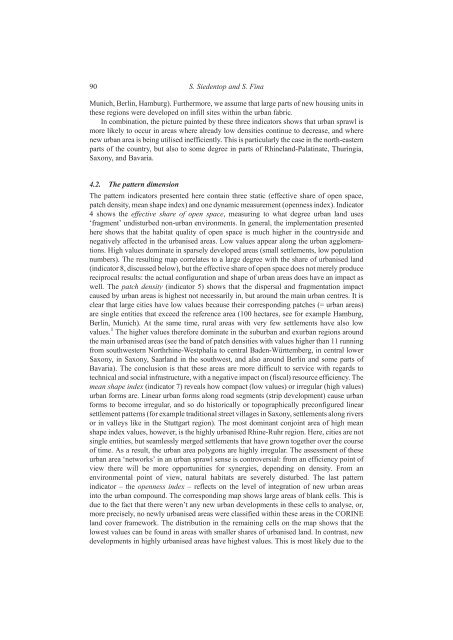PDF 20.134kB - TOBIAS-lib - Universität Tübingen
PDF 20.134kB - TOBIAS-lib - Universität Tübingen
PDF 20.134kB - TOBIAS-lib - Universität Tübingen
Erfolgreiche ePaper selbst erstellen
Machen Sie aus Ihren PDF Publikationen ein blätterbares Flipbook mit unserer einzigartigen Google optimierten e-Paper Software.
90 S. Siedentop and S. Fina<br />
Munich, Berlin, Hamburg). Furthermore, we assume that large parts of new housing units in<br />
these regions were developed on infill sites within the urban fabric.<br />
In combination, the picture painted by these three indicators shows that urban sprawl is<br />
more likely to occur in areas where already low densities continue to decrease, and where<br />
new urban area is being utilised inefficiently. This is particularly the case in the north-eastern<br />
parts of the country, but also to some degree in parts of Rhineland-Palatinate, Thuringia,<br />
Saxony, and Bavaria.<br />
4.2. The pattern dimension<br />
The pattern indicators presented here contain three static (effective share of open space,<br />
patch density, mean shape index) and one dynamic measurement (openness index). Indicator<br />
4 shows the effective share of open space, measuring to what degree urban land uses<br />
‘fragment’ undisturbed non-urban environments. In general, the implementation presented<br />
here shows that the habitat quality of open space is much higher in the countryside and<br />
negatively affected in the urbanised areas. Low values appear along the urban agglomerations.<br />
High values dominate in sparsely developed areas (small settlements, low population<br />
numbers). The resulting map correlates to a large degree with the share of urbanised land<br />
(indicator 8, discussed below), but the effective share of open space does not merely produce<br />
reciprocal results: the actual configuration and shape of urban areas does have an impact as<br />
well. The patch density (indicator 5) shows that the dispersal and fragmentation impact<br />
caused by urban areas is highest not necessarily in, but around the main urban centres. It is<br />
clear that large cities have low values because their corresponding patches (= urban areas)<br />
are single entities that exceed the reference area (100 hectares, see for example Hamburg,<br />
Berlin, Munich). At the same time, rural areas with very few settlements have also low<br />
values. 1 The higher values therefore dominate in the suburban and exurban regions around<br />
the main urbanised areas (see the band of patch densities with values higher than 11 running<br />
from southwestern Northrhine-Westphalia to central Baden-Württemberg, in central lower<br />
Saxony, in Saxony, Saarland in the southwest, and also around Berlin and some parts of<br />
Bavaria). The conclusion is that these areas are more difficult to service with regards to<br />
technical and social infrastructure, with a negative impact on (fiscal) resource efficiency. The<br />
mean shape index (indicator 7) reveals how compact (low values) or irregular (high values)<br />
urban forms are. Linear urban forms along road segments (strip development) cause urban<br />
forms to become irregular, and so do historically or topographically preconfigured linear<br />
settlement patterns (for example traditional street villages in Saxony, settlements along rivers<br />
or in valleys like in the Stuttgart region). The most dominant conjoint area of high mean<br />
shape index values, however, is the highly urbanised Rhine-Ruhr region. Here, cities are not<br />
single entities, but seamlessly merged settlements that have grown together over the course<br />
of time. As a result, the urban area polygons are highly irregular. The assessment of these<br />
urban area ‘networks’ in an urban sprawl sense is controversial: from an efficiency point of<br />
view there will be more opportunities for synergies, depending on density. From an<br />
environmental point of view, natural habitats are severely disturbed. The last pattern<br />
indicator – the openness index – reflects on the level of integration of new urban areas<br />
into the urban compound. The corresponding map shows large areas of blank cells. This is<br />
due to the fact that there weren’t any new urban developments in these cells to analyse, or,<br />
more precisely, no newly urbanised areas were classified within these areas in the CORINE<br />
land cover framework. The distribution in the remaining cells on the map shows that the<br />
lowest values can be found in areas with smaller shares of urbanised land. In contrast, new<br />
developments in highly urbanised areas have highest values. This is most likely due to the

















